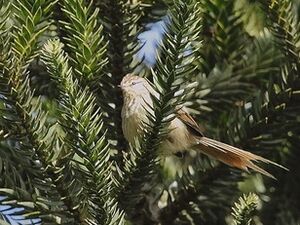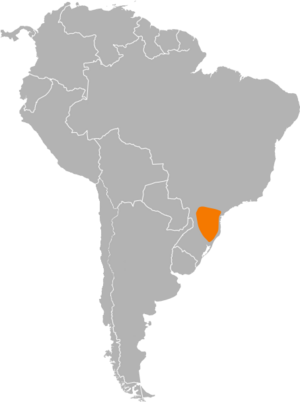Striolated tit-spinetail facts for kids
Quick facts for kids Striolated tit-spinetail |
|
|---|---|
 |
|
| Conservation status | |
| Scientific classification | |
| Genus: |
Leptasthenura
|
| Species: |
striolata
|
 |
|
The striolated tit-spinetail (Leptasthenura striolata) is a small, active bird that lives only in Brazil. It's part of the ovenbird family, known for building interesting nests. This bird is recognized by its long tail and unique striped look.
Contents
About This Bird
The striolated tit-spinetail is a unique bird because it's the only one of its kind in its group. In some parts of Brazil, people call it grimpeirinho.
What It Looks Like
The striolated tit-spinetail is about 15 to 16 centimeters (6 inches) long. It weighs around 10 to 11 grams (less than half an ounce). It's a small bird with a long tail and a short beak. Both male and female birds look the same.
They have a light, buff-white stripe above their eyes. Their face is mostly gray. The top of their head is black with buff-colored stripes. Their back is brown with clear buff stripes. Their wings are dark brown with lighter edges on the feathers.
Their tail is mostly brown, but the outer feathers have a reddish-brown color. The tail feathers are different lengths, making the tail look forked. The bird's belly and chest are a pale, dull yellow-brown. They have brownish speckles on their throat and upper chest.
Their eyes are dark brown. Their beak is black, with a pinkish-gray color at the bottom part. Their legs and feet are greenish. Young birds have less clear stripes and a shorter, less forked tail than adult birds.
Where It Lives
The striolated tit-spinetail is found in southern Brazil. You can see it in the states of Paraná and Santa Catarina. It also lives a little bit into northern Rio Grande do Sul.
This bird likes to live in temperate forests. It especially likes forests with Podocarpus and Araucaria trees. It also lives near rivers in thick bushes and in forests that have grown back after being cut down. It prefers the edges of forests and rarely goes deep into tall forests. You can find it at elevations between 500 and 1200 meters (1,600 to 3,900 feet) above sea level.
Behavior
Movement
The striolated tit-spinetail stays in the same area all year round. It does not migrate to other places.
Feeding Habits
This bird eats arthropods, which are like insects and spiders. It usually hunts for food in pairs. Sometimes, it joins groups of different bird species that are feeding together. It looks for food from the lower parts of the forest up to the very tops of the trees. It picks prey off leaves and branches. It often hangs upside down to reach its food!
Reproduction and Life Cycle
The striolated tit-spinetail builds its nest during the spring and summer in the Southern Hemisphere. These birds stay with one partner. They build a platform nest using twigs and moss. They line the inside with soft feathers. They usually place their nests in natural holes in trees or in old holes made by woodpeckers. Both parents help feed the baby birds.
What It Sounds Like
The song of the striolated tit-spinetail is a short, fast series of 2 to 5 very high, thin notes. The last note is often a bit lower. People describe its song as "psi, psi-psi, ks-ks-ksks-ks". Its calls are a mix of squeaky sounds.
Conservation Status
The IUCN (International Union for Conservation of Nature) has decided that the striolated tit-spinetail is a species of "Least Concern." This means it is not currently in danger of disappearing. It lives across a large area, and even though we don't know the exact number of birds, its population seems to be stable. There are no immediate threats to this bird. It is considered fairly common and can even be found in areas changed by humans.


